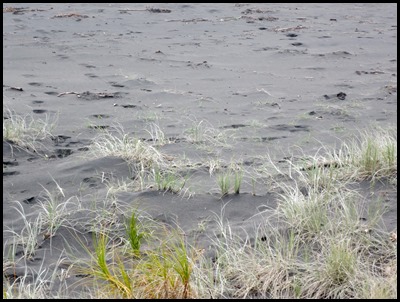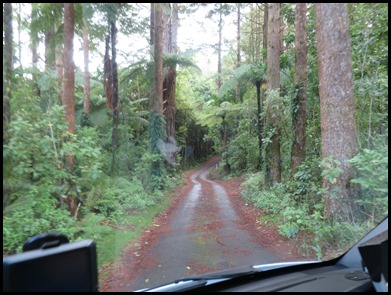To Wellington

|
Our Trip from Lucy’s Beach to the
Outskirts of Wellington
  We woke up at seven, no idea what sight
would be opposite Mabel. We found ourselves looking
at a black, rocky beach complete with man on paddle
boarding.
  The black sand
was a bit of a surprise. Looking away to the
right.
 To the left,
there were people walking dogs already.
  We left the gravel road, soon onto tarmac once more, heading out to the main road. We crossed over and followed a tourist sign to Lucy’s Gully. Among the towering redwoods rise clumps of native trees. They seem to have scant regard for the work done by Sir Victor Davies in the 1920’s when he cleared the land and planted one hundred and fifty back-breaking hectares of exotics. It seems more a tribute to Lucy Stevens, who grew up in Lucy's Gully, that the bush is trying so hard to return to the way it used to be.
A Local Personality: Lucy's connection with the gully began in 1820 when she was born in a whare next to the Waimoku stream. Old Maori fortifications had stood on that ground since very ancient times when the land was extensively planted. Lucy's iwi gardened the sunny ridges keeping a watchful eye out for invaders down on the flat coastal plains. When she married and left the area, Lucy lived at Okorotua Pa beside the Oakura River. She would sit outside the blacksmith shop selling whip-ends (or crackers) made of dressed flax to bullock drivers. A bundle of fifty would fetch a single shilling. She also sold ketes filled with mushrooms and blackberries plucked from the Kaitake slopes. Though her toothless grin and deeply tattooed face sometimes frightened children, Lucy was noticeably fond of both her Maori and Pakeha 'pickaninnies'. With dark eyes peeping out from beneath her black shawl, which often bore a wreath of kawakawa on top, she would happily waylay any child or adult who wandered past.
An Opinionated Woman: Lucy was called a 'Queen's Maori' during the Taranaki Wars because she backed the Government against the Hauhau, yet everyone knew her to be kind and compassionate. She enjoyed nothing better than a chat about olden times. Some days she walked all the way to Okato, down Hampton Road to Parawaha Pa by the Mangakino stream, to catch up with family gossip. When her husband and two sons died, she buried them in a small gravesite at the gully she knew so well, and every year she would trek there from Oakura to hold her own private tangi. There she would indulge in an entire day and night of fasting and lamenting.
War comes to the Gully: In 1864, Government troops attacked two pa sites south of Oakura. Howitzers, rockets and mortars flew overhead, while a force of bushrangers attacked from above. When the defenders fled, the Kaitake Redoubt was established to stop them coming back to claim the land. Soon after the attack, the 57th Regiment were ambushed while harvesting crops on a plateau near Lucy's Gully and suffered heavy casualties from Hauhau warriors hidden in a zigzag trench covered with fern. Captain Lloyd lost his life and his head, which the Hauhau took to Wanganui to impress potential followers. After the ambush, bushrangers chased the war party through the bush, burning whares at Te Ahu Ahu Pa and Waikukupa Pa, both of which had already been abandoned.
A Hint of Gold: The
area created a brief flurry of interest in 1868 when a man named Wilson found a
lump of quartz on Oakura beach which contained a speck of gold. Suddenly,
all eyes turned towards the hills and two men began prospecting at Boar's Head
Creek, not far from Lucy's Gully. Their mine was called Hit and Miss, and
didn't produce enough gold to do anything but dream on.
Lucy's Gully Today: Though little information survives on Lucy Stevens, the Karaka trees planted by her ancestors still abound in the Kaitake ranges. And though the small plot where she tended the graves of her men no longer exists, the site might still be found if you look hard enough.
This track took us through woods, at the end the signs told us about many different walks from half an hour to four and a half. Off we went.  So wowed by Mount
Taranaki, he got his own blog. We followed the Surf Highway. Our tourist
radio told us which way the surf came in, the height of the waves during the
summer months and where all the campsites were. We carried on toward
Wellington.
   We passed through little towns and hamlets, in between a long, straight highway.
The statue – above centre, as tourist radio told us – is of Sir Peter George Snell, KNZM, OBE, (born on the 17th of December 1938 in Opunake) is a former New Zealand middle-distance runner, now resident in Texas, USA. He had one of the shortest careers of world famous international sportsmen, yet achieved so much that he was voted New Zealand’s "Sports Champion of the (20th) Century" and was one of 24 inaugural members of the International Association of Athletics Federations Hall Of Fame named in 2012. A protégé of the great New Zealand athletics coach Arthur Lydiard, Snell is known for the three Olympic and two Commonwealth Games gold medals he won, and the several world records he set.   We had to do a left, left and left again
when Bear spotted Bear Street and Bear Street Medical
Centre.
 I spotted a ‘one
careful owner’ abandoned in the middle of a field.
  We looked left and right over the Whanganui River. The town is spelt Wanganui as the
first European settlers couldn’t spell the local way. This caused a row over the
years, the Government eventually stepped in and ask the townsfolk to vote. Not
enough people came down one side or the other, so, the town stays one way and
the river the other and it has been officially declared that either is
correct...........
 Driving through the township called Bulls was funny. Tourist radio told us to look out for
signs as we went through. Four Square Bulls, the village shop. What a Load of
Bulls. Bulls Fish n’ Chips. Scrappers Bulls. Bulls Dairy. Bulls Builders. Good
fun indeed.
Wiki says: Bulls is a small town near Palmerston North on the west coast of the North Island of New Zealand. It is in a thriving farming area in the Rangitikei District at the junction of State Highways 1 and 3 about 160 kilometres north of Wellington. In the 2001 census it had a population of 1755. The eastern end of the SH1 bridge over the Rangitikei River south-east of the town collapsed suddenly in 1973 while being crossed by a bus. No-one was killed and the collapsed part was rebuilt. Many of the aircrew from the nearby Royal New Zealand Air Force base at Ohakea live in Bulls. Former Formula One racing driver Chris Amon was born in the region and until recently ran the Amon family farm in the nearby village of Scotts Ferry. Nowadays he lives in the lakeside town of Taupo. The former Lake Alice Psychiatric hospital is 8 km north of Bulls, the hospital closed in 1999. Lake Alice was a large contributor to the Bulls and Marton economy. Recent marketing makes puns with the name, for example "New Zealand gets its milk from Bulls" or the sign for the local police station "Const-a-bull". Observers may consider the results "commenda-bull" or "horri-bull". If you visit the information centre you will discover that their sister city is Cowes, England. The town is named after James Bull, who founded the town and owned the first general store there. The town was originally called Bull Town, but this was changed to Clifton and then renamed back to Bulls at the urging of Sir William Fox.
 Bear liked this picture of a car and boat.
 The cloud line above
the conference of cows also made us smile. We stopped at a massive out of
town place not far from Wellington for Bear to buy a couple of posh adaptor
plugs, his free ones – clearly not up to the task – had melted in a plug hole.
That done we pulled in to Newlands five miles from the city. Free hour of wi-fi
and free electricity. This bare car or should I say van park is at the rear of a
hotel / motel complex. We have our own shower block, kitchen, laundry. Showers
are free, you have to remember to press a button before entering for ten minutes
of piping hot water. There is a water and toilet dump. Bear went to empty our
waste water only to find Vera had left our outlet pipe open, we have innocently
been baddies dropping the odd cup worth hither and thither, so pleased we have
not been caught as that is a two hundred dollar on the spot fine. Valve now
closed. Today we have travelled one hundred and fifty miles.Tomorrow on the bus
to explore Wellington before the ferry journey on Tuesday. All well with
Mabel.
ALL IN ALL A BIT OF
EVERYTHING |
